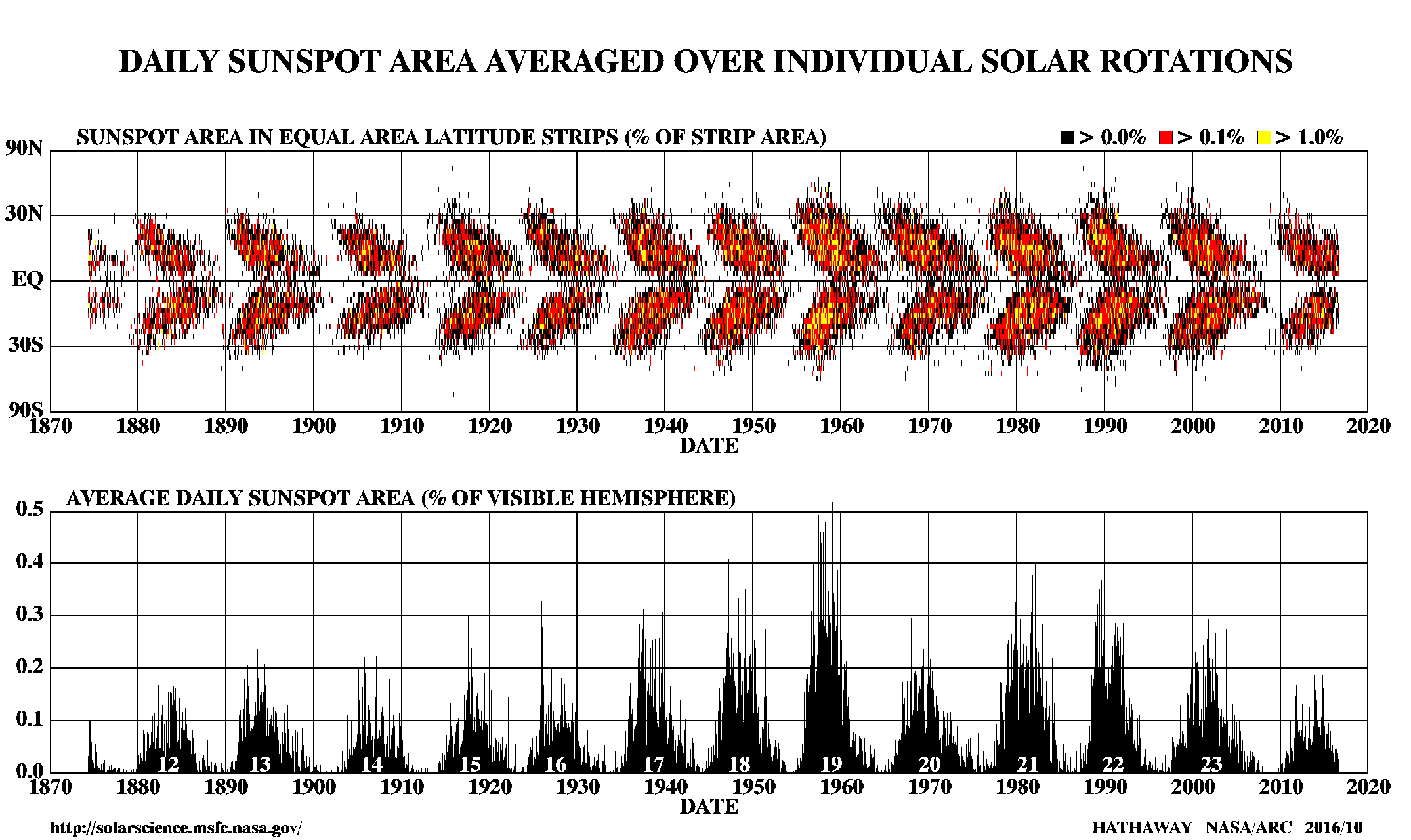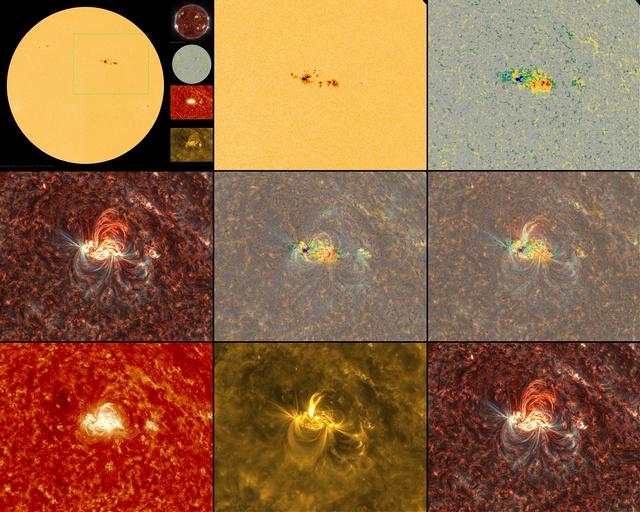Solar Cycle 25 Started on Remarkable Times
Abstract:
First sunspots of solar cycle 25 appeared already in year 2019, according to their polarity. This work lists their dates, with some introduction about sunspot cycle and magnetic "color" (polarity) of sunspots.Sunspot Cycle
Solar magnetic activity has a cycle of approximately 11 years. But since the polar field of the Sun changes around time of solar maximum, and direction of sunspots is different in each cycle, it can be better understood as 22 year cycle (Hale cycle).First sunspots of the cycle start appearing at high latitudes, and then the sunspot belt shifts continually toward the solar equator, which produces the well-known butterfly diagram, which is linked to the faster-moving belt of torsional oscilation.
First sunspots of new cycle often appear, while there are still some sunspots of the old cycle.
Since 1874, sunspot positions were recorded at Greenwich observatory and then since 1977 continued by USAF by Solar Optical Observing Network.
I determined solar cycle starts by first appearance of high-latitude sunspots in that dataset, and since magnetic observations are available, from SOHO/MDI and SDO/HMI instruments:
| Cycle | Starting time | Possibly other starting time |
|---|---|---|
| SC 12 | 1879-04-15 | |
| SC 13 | 1890-03-04 | |
| SC 14 | 1902-03-06 | |
| SC 15 | 1913-10-08 | 1913-02-22 |
| SC 16 | 1923-09-04 | |
| SC 17 | 1934-02-01 | |
| SC 18 | 1943-05-20 | |
| SC 19 | 1954-10-05 | 1954-07-16 |
| SC 20 | 1963-10-11 | |
| SC 21 | 1975-10-02 | 1975-08-21 |
| SC 22 | 1986-07-07 | 1984-11-21 |
| SC 23 | 1996-05-07 (SOHO/MDI) | 1997-03-29 |
| SC 24 | 2008-09-23 (SOHO/MDI) | |
| SC 25 | 2016-12-11 (SDO/HMI) | 2019-02-12 (SDO/HMI) |
Most people (who know about sunspots) think, that sunspots are dark and color-less, but actually they are very colorful, but in different part of light spectrum, in extreme ultra-violet and X-ray part of spectrum.
Normal solar surface has black-body radiation around 6,000°K, but magnetic loops above sunspots are almost 1,000,000°K hot.
 Color scale used for magnetograms from
JSOC.
Color scale used for magnetograms from
JSOC.
Sunspot Polarity
But sunspots also have a "magnetic color", or rather a polarity of their strong magnetic field. Sunspots of each new cycle have oppositely oriented their positive and negative ends, and sunspots on northern hemisphere are oppositely oriented than sunspots on southern hemisphere: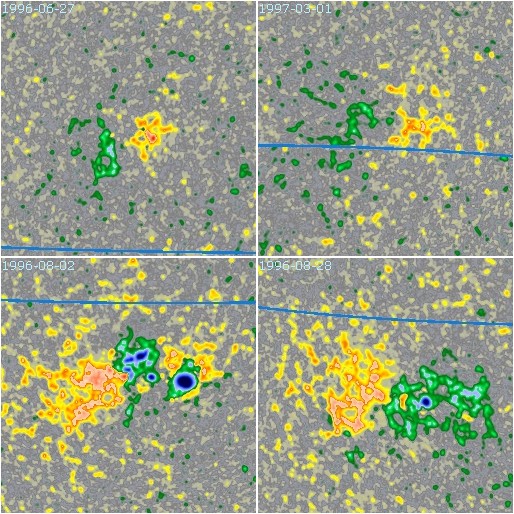 Examples of polarity of sunspots in late SC 22, northern and southern hemispheres
Examples of polarity of sunspots in late SC 22, northern and southern hemispheres
These magnetograms are filtered with low-frequency filter (FFT-2D) to remove noise in SOHO/MDI magnetograms, and same is applied on SDO/HMI magnetograms for visual unification, and equator is drawn as a blue line.
 Examples of polarity of sunspots in SC 23, northern and southern hemispheres
Examples of polarity of sunspots in SC 23, northern and southern hemispheres
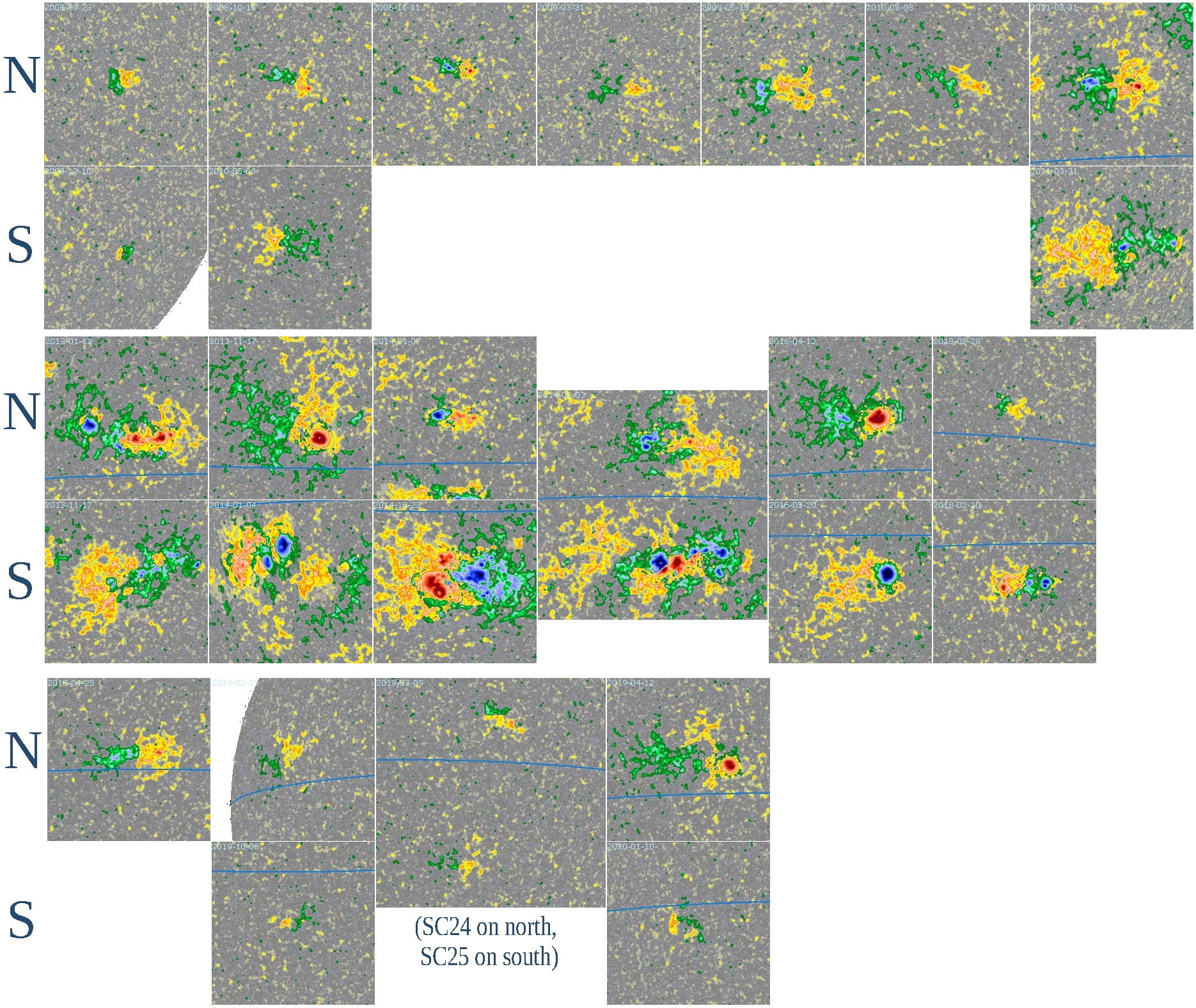 Examples of polarity of sunspots in SC 24, northern and southern hemispheres
Examples of polarity of sunspots in SC 24, northern and southern hemispheres
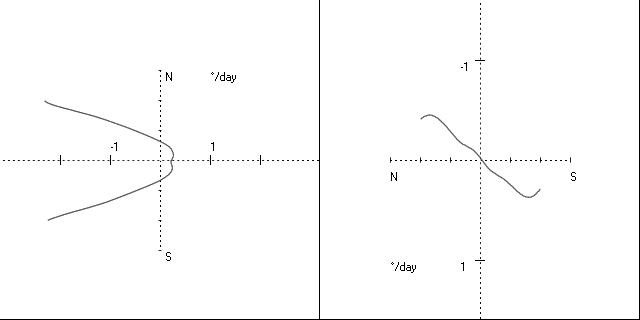
Differential rotation profile in deg/day difference from Carrington rotation, 2010-2018
In SC23 and SC25, northern sunspots have positive field on leading (right) side (green color), negative field on trailing (left) side (yellow color), and southern sunspots are opposite.
(Animated Magnetic Map of Sun videos are available for SC 24 and SC 23 in rectangular projection, front side of Sun is as observed, far side of Sun is interpolated, flow profile of differential rotation is as measured by feature-tracking on SDO/HMI magnetograms...)
Notice, that SC24 (2008-2020) has been notably weaker than SC23 (1996-2009).

Magnetic field during solar cycles 23 and 24, one image per year, selecting some more active time of that year. ( SC23, SC24, video )
Some Active Regions evolve stronger and there appears a sunspot in visible spectrum, some do not.
Sunspot Cycle 25
Sunspot minimum after SC 24 has been unusually deep, calm and long, similarly as sunspot minimum between SC 23 and SC 24, both being deepest minimums in at least a century...First sunspots or active regions of SC 25, as determined by their polarity, different from SC 24 sunspots, appeared occasionally since December 2016, but then since February 2019 started to appear more frequently. Sunspots of old cycle SC 24 still occur in early 2020...
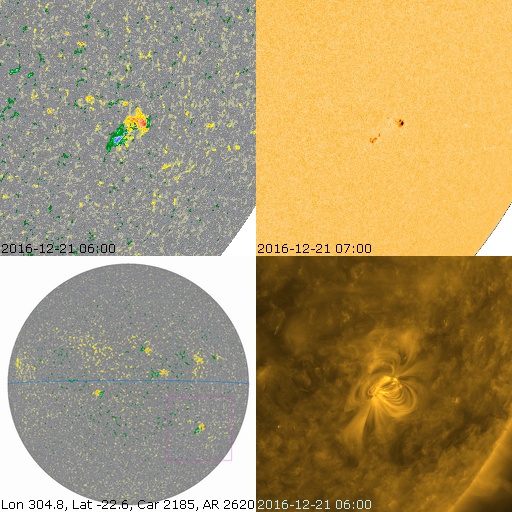
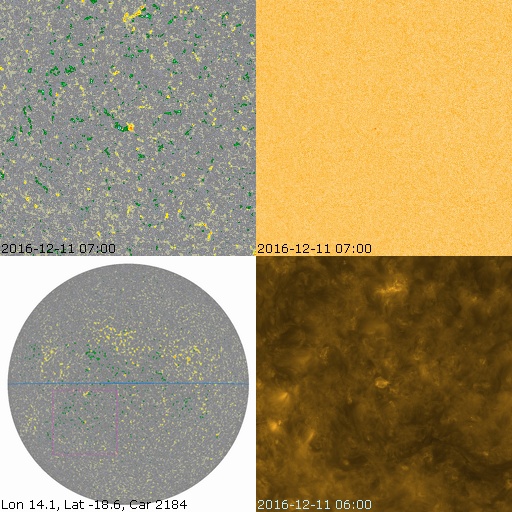
Next active region of SC 25 appeared on evening of Fourth Advent Sunday, on 2016-12-18, with a sunspot appearing the next day and intensifying on 2016-12-20. (Ref 8, Ref 9)
The cycle SC 24 was still underway and these were unexpected...
Possible remnant of another active region of SC 25 rolled into view on eastern limb on 2017-07-01 with no more sunspots, on a relatively low latitude of 14° South. It originated some time between 2017-06-17 and 2017-06-22 on far side of the Sun. (As it rolled into view of Stereo A, while the originating place could have been seen by Stereo B, if it was still operating.)
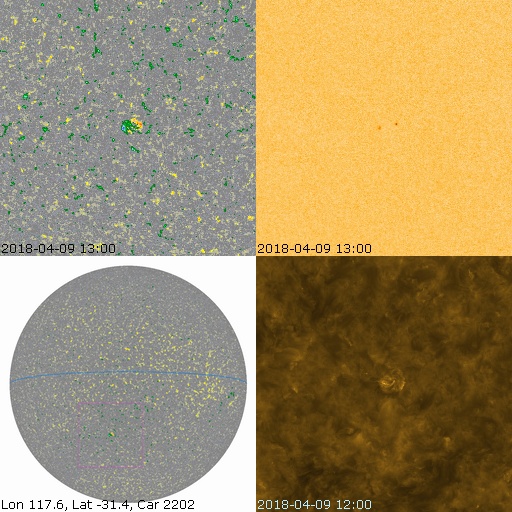
A very tiny and short-duration sunspot appeared on International Students Day, on 2018-11-17, which is also a "Struggle for Freedom and Democracy Day" in Czech and Slovak republics.
It was a first sunspot on northern hemisphere. (Ref 9)
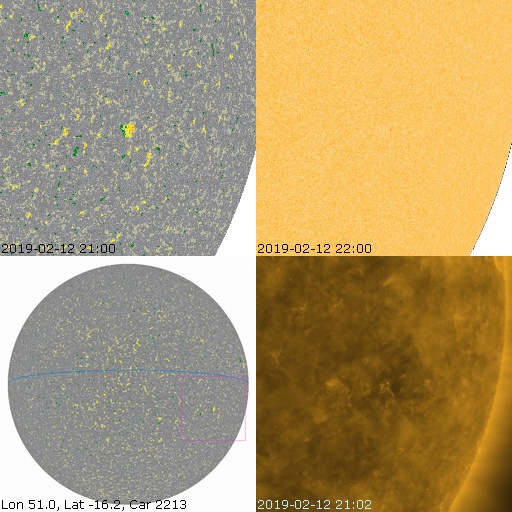
(Also notable on this day 3 years ago in 2016 Pope Francis and Patriarch Kirill signed
an Ecumenical Declaration
in the first such meeting between leaders of the Catholic and Russian Orthodox Churches
since their split in 1054...)
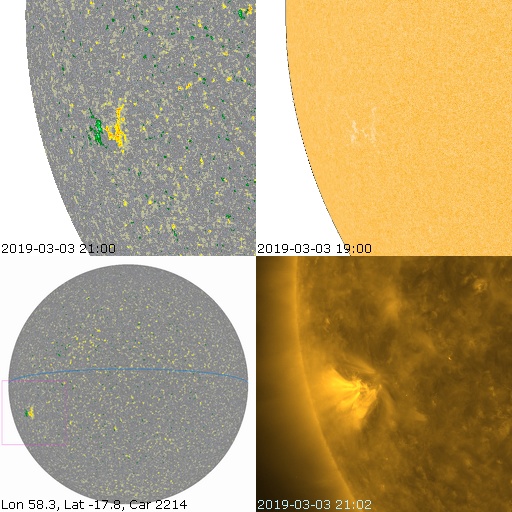
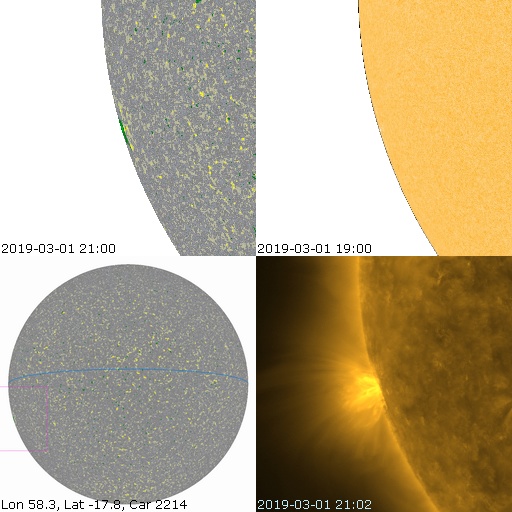
(At Roman antiquity times, year started in March,
as is still evidenced by month names September to December being named by latin numerals 7 to 10,
while the first months are named by Roman Emperors - Marcus Aurilius Maius Iunius Julius Augustus?)
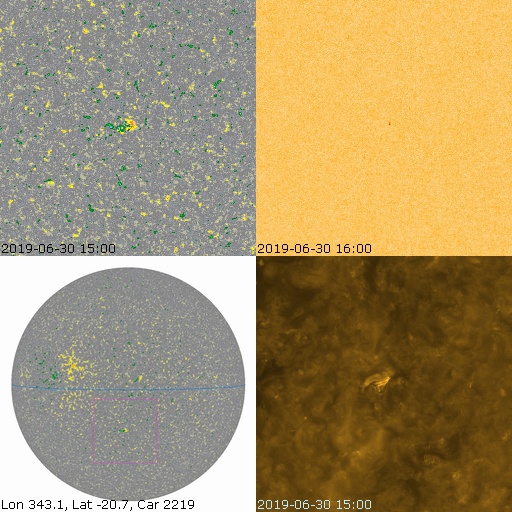
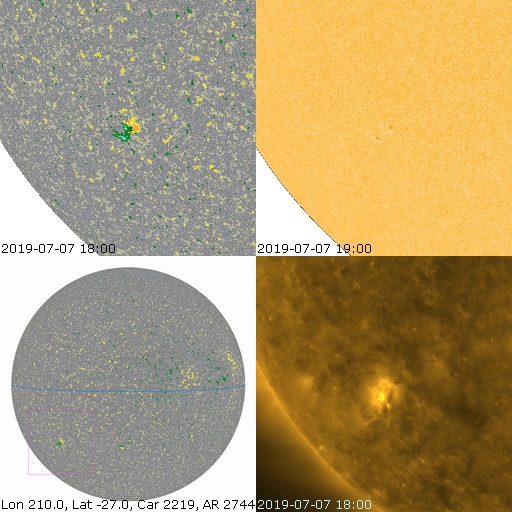

As Jan Hus appealed his condemnation by a rogue council,
which was quarreling for a political might at the time of three popes,
to the Jesus Christ himself, no-one on Earth could arbitrate his case or holiness before,
even when pope Jan Paul II. apologized for his execution at year 2000.
But this time the arbitration in favour of sanctity of Jan Hus came undeniably from the Sun from God and 24 "old ones"...
But this time the arbitration in favour of sanctity of Jan Hus came undeniably from the Sun from God and 24 "old ones"...
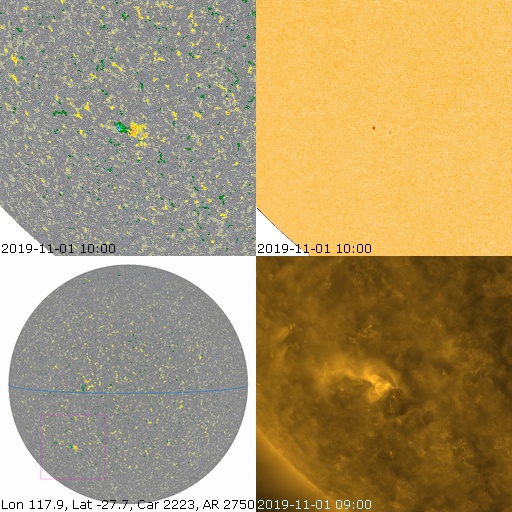
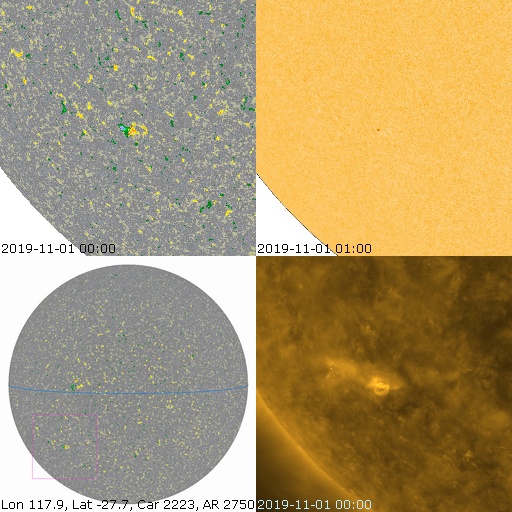

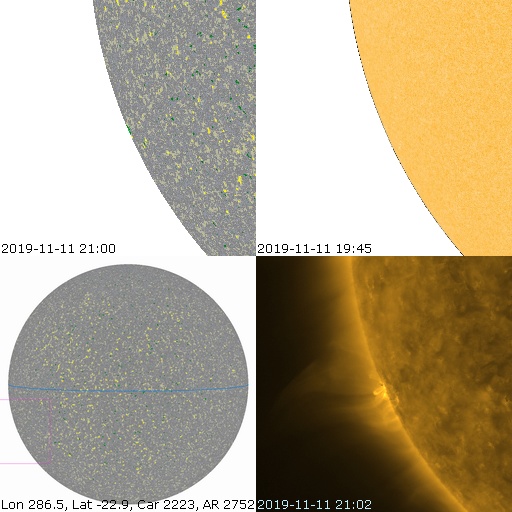
(Earlier on this day 2019-11-11, between 12:40 UTC and 18:07 UTC occured transit of Mercury in front of Sun with center at 15:25:14 UTC)
It is also an Armistice Day, celebrating the end of World War...
(A short sunspot also appeared in this Active Region around midnight between 2019-11-17 and 2019-11-18 ...)
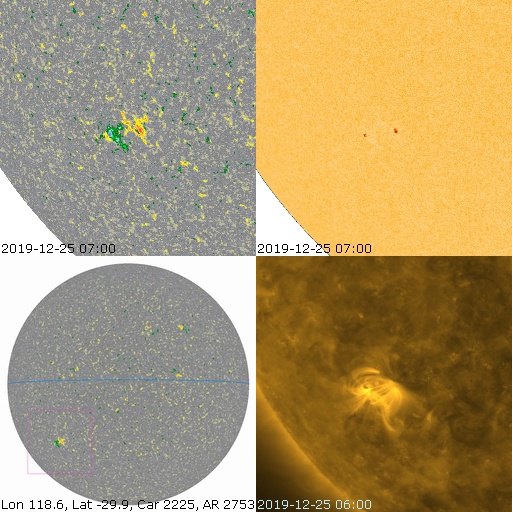
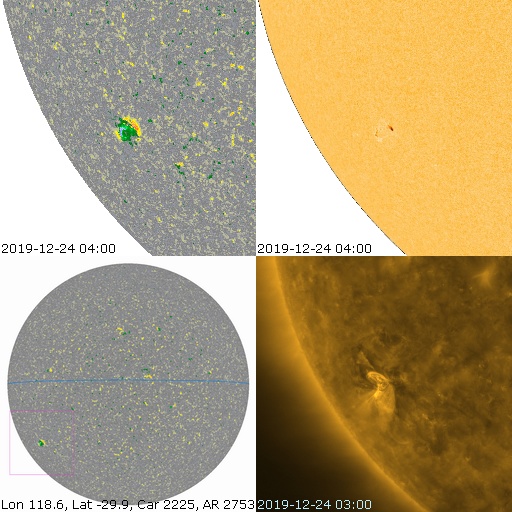
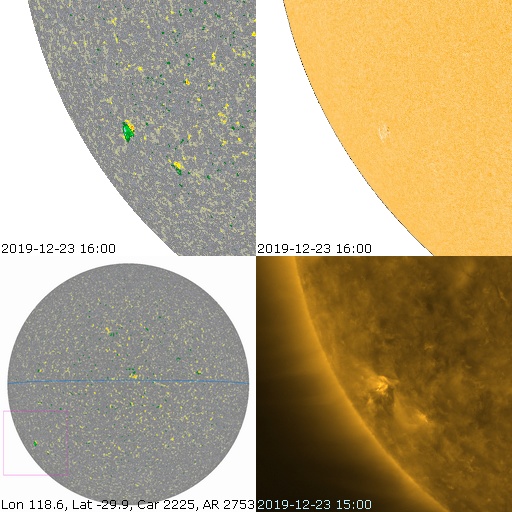
(Proper dating of Bethlehem star is on 23rd December 3 BC in proleptic gregorian calendar)
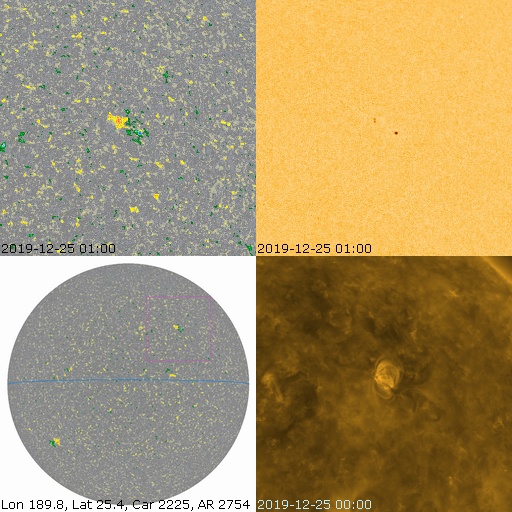
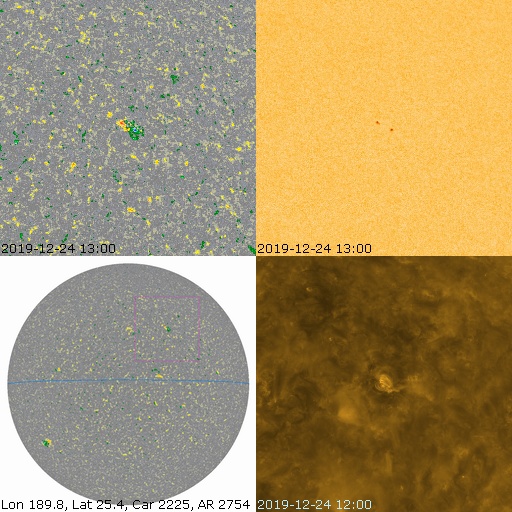
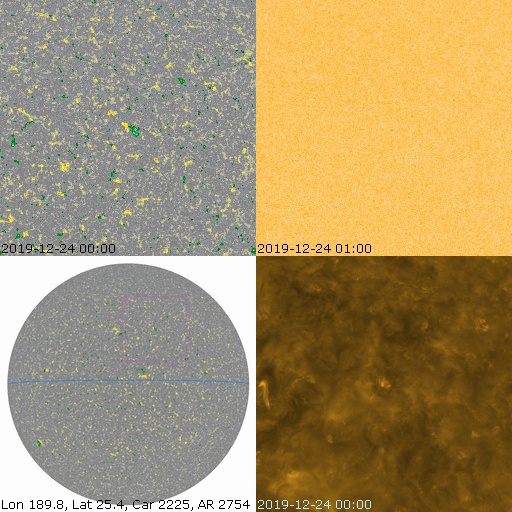
(Other reported Active Regions (Ref 12) were not sufficiently resolved or clearly oriented in new way and were rather part of a normal noise.)
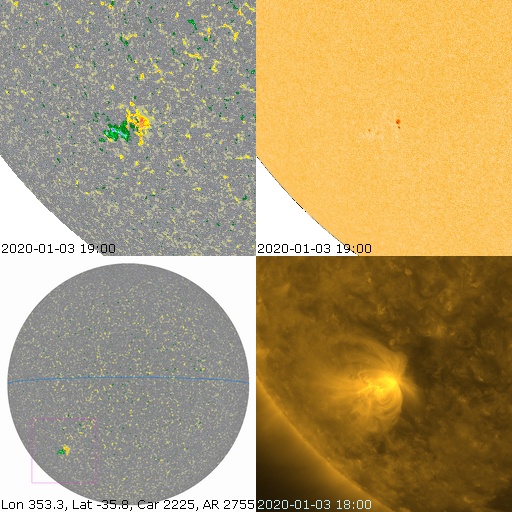
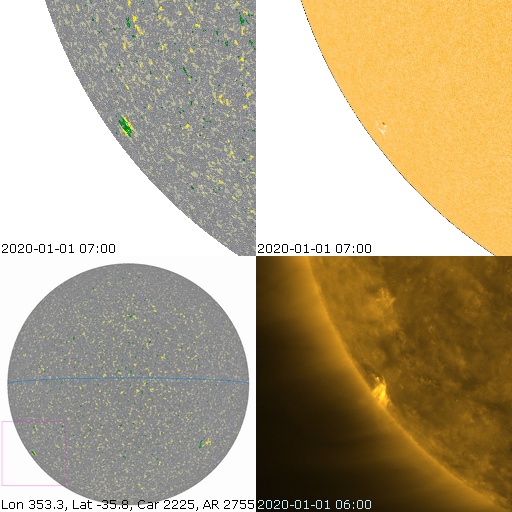
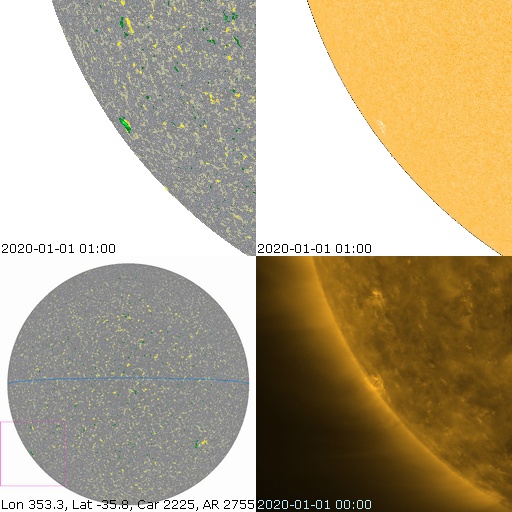
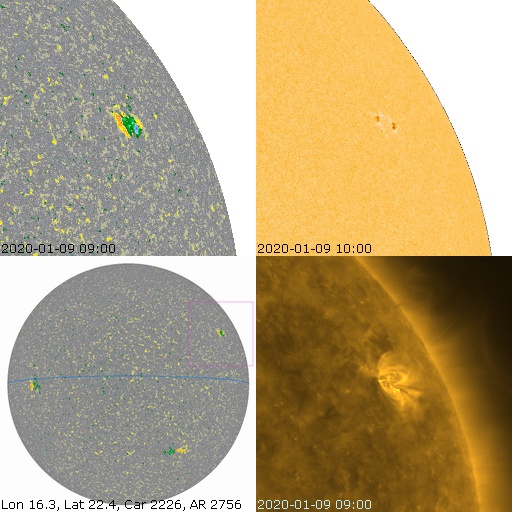
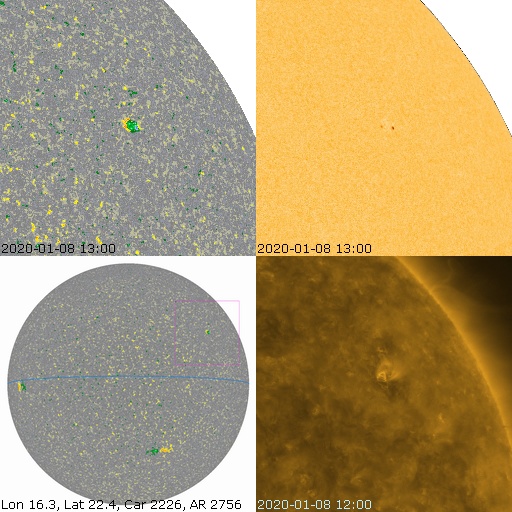
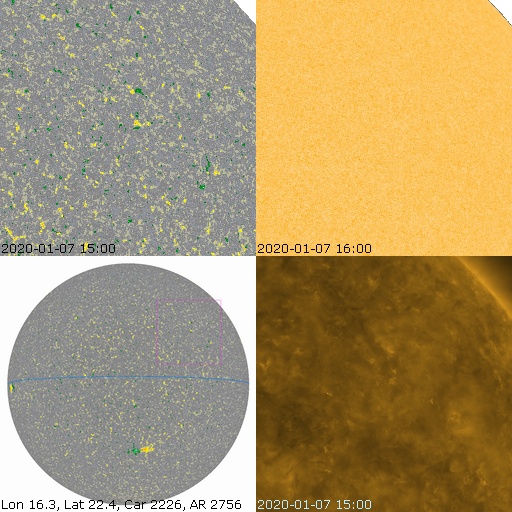
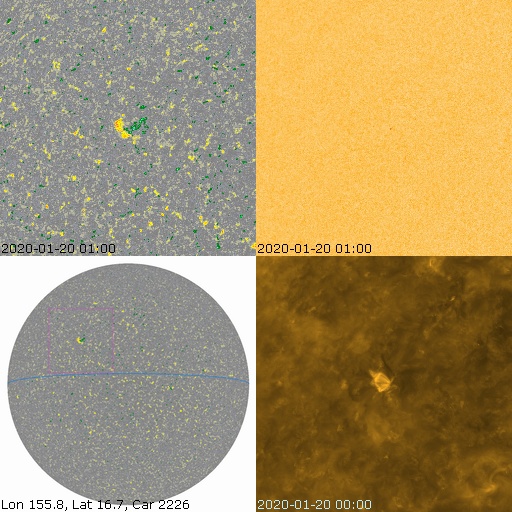
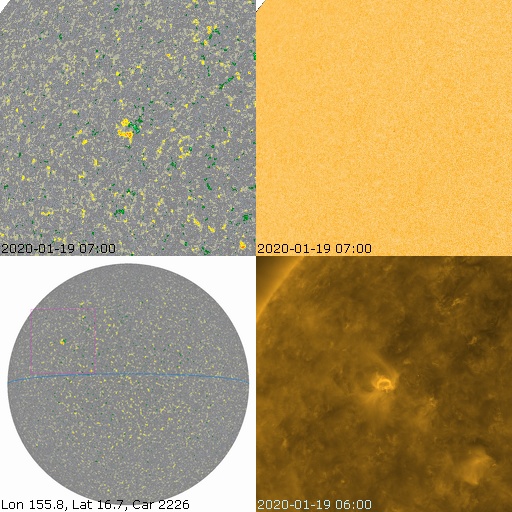
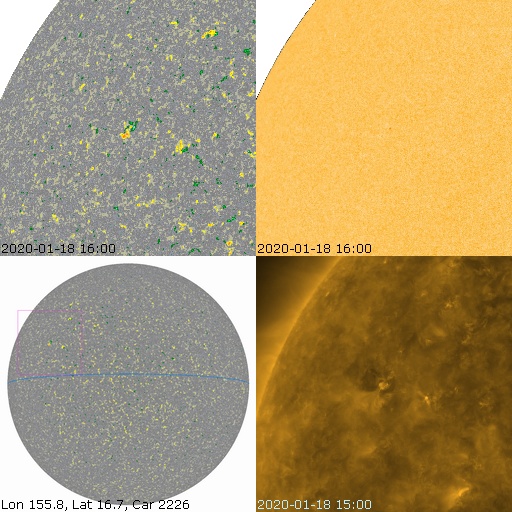
(January 19 is date of Epiphany in Eastern Orthodox church... January 20 has multiple meanings...)
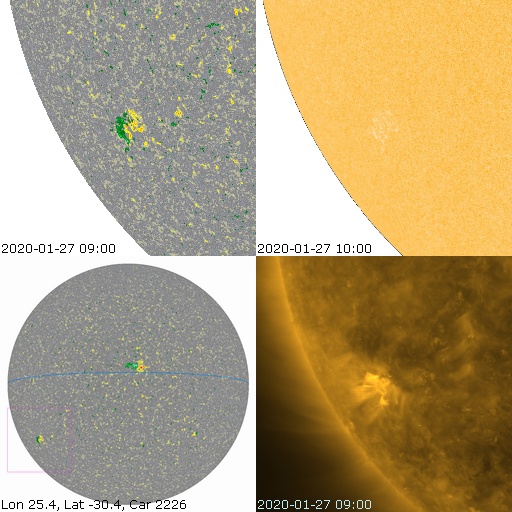
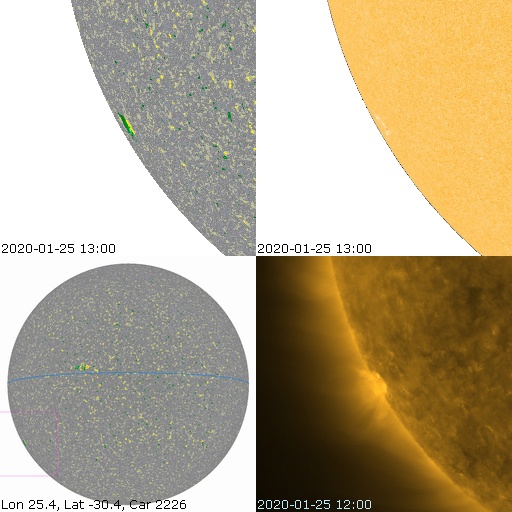
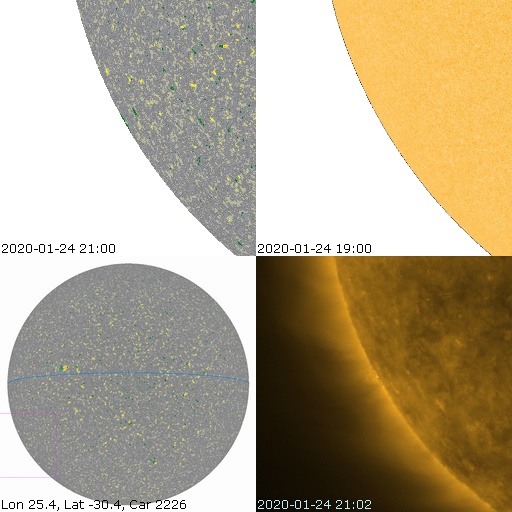
(This year is a Year of the Mouse...)
| Time of Active Region appearance on Magnetogram |
Time of Sunspot on Intensitygram |
Remarks |
|---|---|---|
| 2016-12-11 00:00 (new, tiny) | 2016-12-11 07:00 | Third Advent Sunday |
| 2016-12-18 09:00 (new) | 2016-12-19 16:00 | Fourth Advent Sunday (AR 2620) |
| 2018-04-09 02:00 (new) | 2018-04-09 11:00 | Orthodox Easter Monday |
| 2018-11-17 09:00 (new, northern) | 2018-11-17 16:00 | International Students' Day |
| 2019-02-12 16:00 (new) | 2019-02-12 22:00 | Darwin Day |
| 2019-03-01 18:00 (rolling on limb) | Roman New Year | |
| 2019-06-29 21:00 (new) | 2019-06-30 16:00 | Saints Peter and Paul |
| 2019-07-06 12:00 (new) | 2019-07-06 16:00 | martyrdom of Jan Hus (AR 2744) |
| 2019-10-31 06:00 (new) | 2019-11-01 01:00 | All Saints Day (AR 2750) |
| 2019-11-11 21:00 (rolling on limb) | 2019-11-12 13:00 | Saint Martin (AR 2752) |
| 2019-12-23 06:00 (new) | 2019-12-23 16:00 | Christmas Day (almost) (AR 2753) |
| 2019-12-23 21:00 (new, northern) | 2019-12-24 13:00 | Christmas Eve (AR 2754) |
| 2019-12-31 23:00 (new) | 2020-01-01 04:00 | New Year Day (AR 2755) |
| 2020-01-07 12:00 (new, northern) | 2020-01-08 13:00 | Orthodox Christmas Day (AR 2756) |
| 2020-01-18 06:00 (new, northern) | 2020-01-18 13:00 2020-01-19 19:00 | Orthodox Epiphany |
| 2020-01-24 21:00 (rolling on limb) | 2020-01-25 13:00 | Chinese New Year |
Conclusion
While on former years, sunspots seemed to appear in relation with planetary positions (Apparent Relations between Solar Activity and Solar Tides, Ching-Cheh Hung 2007 - [archived]), or at random, this time their correspondence with times of Christian holidays and starts of Calendary does not appear random at all and is hardly deniable...At first in early 2019 I noticed the sunspot on Easter Monday 2018, as I didn't have a calendar and thought it's friday after first spring fullmoon. (After all, it's Orthodox Easter Monday 2018 a week later...) Then I noticed the Jan Hus sunspot, a nice coincidence. But when I noticed sunspot on Christmas Eve, it was clearly a message. (I was not specifically hunting for new sunspots, but doing routine quality control of input data for a scientific project...) Then investigating other sunspots in 2019, I noticed other dates of calendar starts and various saints and it confirmed the message. Only when trying to publish this, I noted other works listing other sunspots, some unexpectedly early in 2016, and needed to fill the table more completely, which somehow diluted the boldness of the message about Darwin and Jan Hus, but not completely, as the position of sunspots on feasts remained consistent.
You may argue, that there are many christian feasts around the year. But these first sunspots of SC 25 are on major christian feasts and holidays, calendary starts, and just two exceptions so far with International Students' Day (November 17) and Darwin Day (February 12).
I understand, that atheistic community would not be pleased by this revelation, and neither the churches, both with their Pride about fictitious infallibility and their superstitions.
Also the scientists just believed incorrect blunders, while scorning at believers for backwardness.
Video (or avi) is available with the Sunpots... (SDO/HMI Magnetogram, cropped and full-disk, SDO/HMIIF Intensitygram, SDO/AIA 171A EUV)
(Updated 2020-02-26, πα½)
References
1. Solar Cycle Science, Dr. David Hathaway, solarcyclescience.com/solarcycle.html2. The Sunspot Cycle, NASA MSFC, solarscience.msfc.nasa.gov/SunspotCycle.shtml
3. Hale Cycle, en.wikipedia.org/wiki/Hale_cycle#Solar_dynamo , archive 2019-10-30
4. The Pattern of Rotation Rate Deviation Known as the Torsional Oscillations, Roger Ulrich, www.astro.ucla.edu/~ulrich/Torsional_Oscillations.html
5. GSSN - Interpolated Sunspot area and Synoptic Sunspot Map 1874-2012, P.A.Semi semi.gurroa.cz/Astro/gssn.html
6. Synoptic Charts of the Photospheric Line-of-Sight Magnetic Field, JSOC, jsoc.stanford.edu/new/HMI/LOS_Synoptic_charts.html
7. Solar and sunspot videos, P.A.Semi, pialpha.cz/Sun
8. The First Signs of Solar Cycle 25, Dean Pesnell, sdoisgo.blogspot.com/2018/04/the-first-signs-of-solar-cycle-25.html
9. A Sunspot from the Next Solar Cycle, Dr.Tony Phillips, spaceweatherarchive.com/2018/11/20/a-sunspot-from-the-next-solar-cycle/
10. A Sunspot from Cycle 25 for sure, Tomek Mrozek and Hugh Hudson, sprg.ssl.berkeley.edu/~tohban/wiki/index.php/A_Sunspot_from_Cycle_25_for_sure
11. SpaceWeather time machine, spaceweather.com/archive.php?view=1&day=24&month=12&year=2019
12. Cycle 25 observations in SDO HMI imagery, Solen Info, solen.info/solar/cycle25_spots.html , archive 2020-01-11
